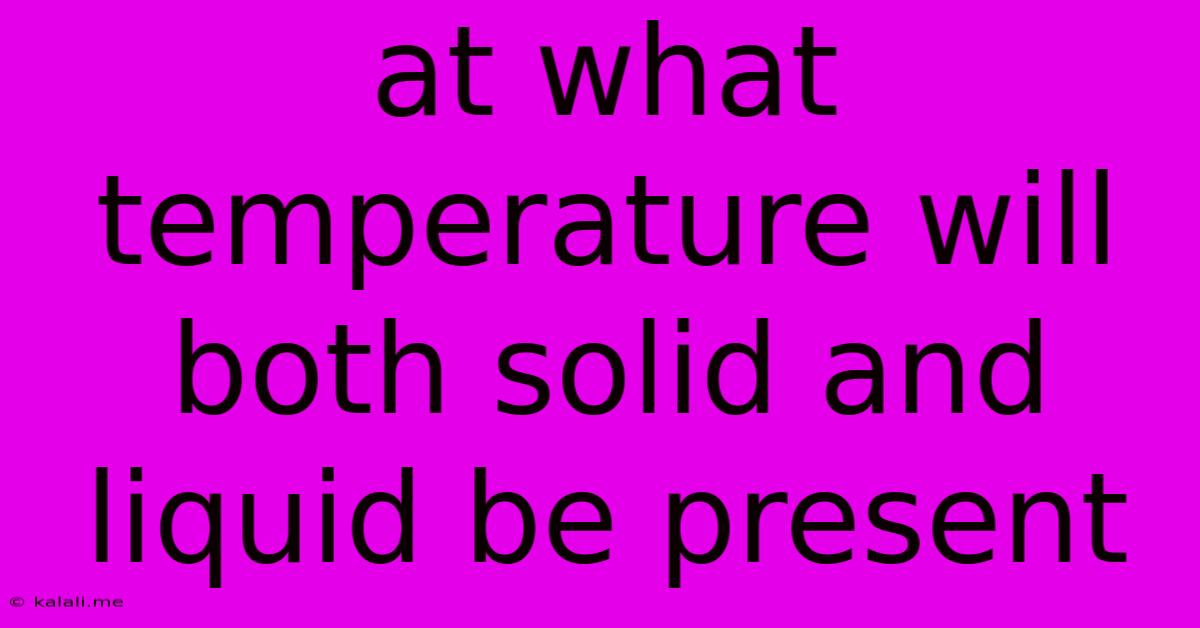At What Temperature Will Both Solid And Liquid Be Present
Kalali
Jun 15, 2025 · 3 min read

Table of Contents
At What Temperature Will Both Solid and Liquid Be Present? Understanding the Melting Point
The temperature at which both the solid and liquid phases of a substance coexist is known as its melting point (or freezing point, depending on the direction of the phase transition). This crucial point is a fundamental concept in physical chemistry and has wide-ranging implications in various fields, from materials science to cooking. This article will delve into the intricacies of melting points, exploring what factors influence them and why they're so important.
What Happens at the Melting Point?
At the melting point, the thermal energy supplied to a solid overcomes the intermolecular forces holding its particles in a rigid, crystalline structure. This energy allows the particles to break free from their fixed positions and transition into a more mobile, liquid state. Importantly, this transition doesn't happen instantaneously; at the melting point, both solid and liquid phases exist in equilibrium – meaning the rate of melting equals the rate of freezing. Think of it like a delicate balance: as solid melts, liquid simultaneously freezes, maintaining a constant temperature until all the solid has transformed.
Factors Influencing Melting Point
Several factors can significantly affect a substance's melting point:
-
Intermolecular Forces: Stronger intermolecular forces (like hydrogen bonds or dipole-dipole interactions) require more energy to overcome, resulting in a higher melting point. Substances with strong intermolecular forces tend to be solids at room temperature, while those with weak forces are often liquids or gases.
-
Molecular Weight: Larger molecules generally have higher melting points because they have more surface area for intermolecular interactions. The increased number of interactions requires more energy to break, leading to a higher melting point.
-
Crystalline Structure: The arrangement of molecules within a solid's crystal lattice also influences its melting point. A well-ordered, tightly packed structure will generally have a higher melting point than a less ordered one. This is because a more ordered structure implies stronger intermolecular forces within the lattice.
-
Pressure: While the effect of pressure on melting point is usually less significant than other factors, increasing pressure generally raises the melting point of most substances. This is because increased pressure favors the denser phase, which is usually the solid state. Water is a notable exception, exhibiting a decrease in melting point with increased pressure.
-
Impurities: The presence of impurities in a substance can lower its melting point. This phenomenon is known as melting point depression and is frequently used in techniques like determining the purity of a substance.
Applications of Understanding Melting Point
Understanding and controlling melting points has numerous practical applications:
-
Material Science: Melting points are crucial in materials science for selecting appropriate materials for specific applications. For example, choosing a material for high-temperature applications requires a high melting point.
-
Chemistry: Melting point determination is a common technique used to identify and characterize compounds. The melting point is a physical property that can be used to identify a substance, and it can also provide information about its purity.
-
Food Science: The melting points of fats and oils are important factors in food processing and cooking. Understanding the melting behavior of these substances helps in creating desired textures and mouthfeels in various food products.
Conclusion
The melting point is a critical property of matter that provides valuable insights into the nature of intermolecular forces and molecular structure. The coexistence of solid and liquid phases at this temperature highlights the dynamic equilibrium between these two states. Understanding the factors that influence melting point is essential in various scientific and technological fields, with applications extending from materials science to food technology.
Latest Posts
Latest Posts
-
Select All Of The Following That Are True About Marsupials
Jun 16, 2025
-
What Is Conjugate Base Of H2po4
Jun 16, 2025
-
Johnson And Wales University Gpa Requirements
Jun 16, 2025
-
National Film Award For Best Music Direction
Jun 16, 2025
-
How Many Bytes Is 1 Tb
Jun 16, 2025
Related Post
Thank you for visiting our website which covers about At What Temperature Will Both Solid And Liquid Be Present . We hope the information provided has been useful to you. Feel free to contact us if you have any questions or need further assistance. See you next time and don't miss to bookmark.